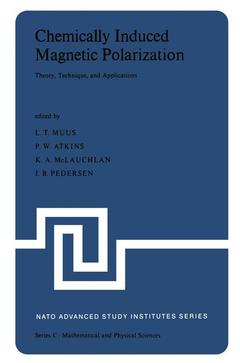Chemically Induced Magnetic Polarization, Softcover reprint of the original 1st ed. 1977 Proceedings of the NATO Advanced Study Institute held at Sogesta, Urbino, Italy, April 17-30, 1977 Coll. Nato Science Series C:, Vol. 34
Langue : Français
Coordonnateurs : Muus L.T., Atkins P.W., McLaughlan K.A., Pedersen J.B.

Magnetic resonance has constantly been able to surprise with its ability to exhibit new phenomena. Just when it appears to be entering a quiet middle age it bursts into activity with some new manifestation of its versatility. This happened a few years ago, when observations on anomalous intensities were looked at more closely, and the pursuit of explanations and further evidence laid the foundations of the subjects treated in this volume. In organizing the NATO Advanced Study Institute we attempted to bring together a number, but by no means all, of those who had contributed significantly to the subject, and to obtain from them a comprehensive and detailed exposition of the subject. We were particularly anxious to avoid a set of lectures that dealt solely with the theory of the subject, because much of the interest in chemically induced magnetic polarization is due to its usefulness in applications to chemical problems: it is a real chemical tech nique, not just an amusing diversion for theoreticians. We set about organizing the course with the idea of making it useful to people who wanted to use the technique (for, after all, in the case of nuclear polarization, CIDNP, the technique can be used in any laboratory with minor modification of standard equipment).
I. Introduction to Chemically Induced Magnetic Polarization.- II. CIDNP Exhibited by Thermally Decomposing Diacyl Peroxides.- III. Time-Dependence of CIDNP Intensities.- IV. Chemically Induced Nuclear Spin Polarization in Photo-Initiated Radical Ion Reactions.- V. Radical Pair Mechanism of Chemically Induced Magnetic Polarization.- VI. Experimental Observation of Electron Spin Polarization in Reactions.- VII. Chemically Induced Electron Polarization of Radiolytically Produced Radicals.- VIII. Flash-Photolysis Electron Spin Resonance.- IX. Time-Dependence of Esr Intensities.- X. Photochemical Processes.- XI. The Triplet Mechanism.- XII. Light Modulated Cidep Experiments.- XIII. Low Field Effects and CIDNP of Biradical Reactions.- XIV. Pair Substitution Effects in CIDNP.- XV. CIDNP from Bimolecular Reactions of Organometallic Compounds.- XVI. The Problem of Parallel Radical and Non-Radical Mechanisms.- XVIII. Effects of Diffusion on Reaction Rates.- XIIX. General Relations for High-Field CIDNP.- XIX. Numerical Methods and Model Dependence in Chemically Induced Dynamic Spin Polarization.- XX. Chemically Induced Magnetic Polarization in Systems of Biochemical Interest.- XXI. Triplet Overhauser Mechanism of CIDNP.- XXII. The Effects of Magnetic Fields on Chemical Reactions.- XXIII. CIDNP from Triplet Pair Recombination.- XXIV. Light-Induced Magnetic Polarization in Photosynthesis.
Date de parution : 11-2011
Ouvrage de 420 p.
15.5x23.5 cm
Disponible chez l'éditeur (délai d'approvisionnement : 15 jours).
Prix indicatif 52,74 €
Ajouter au panierThèmes de Chemically Induced Magnetic Polarization :
Mots-clés :
Chemical reaction; Diffusion; magnetic field; metals; reactions; spin
© 2024 LAVOISIER S.A.S.
